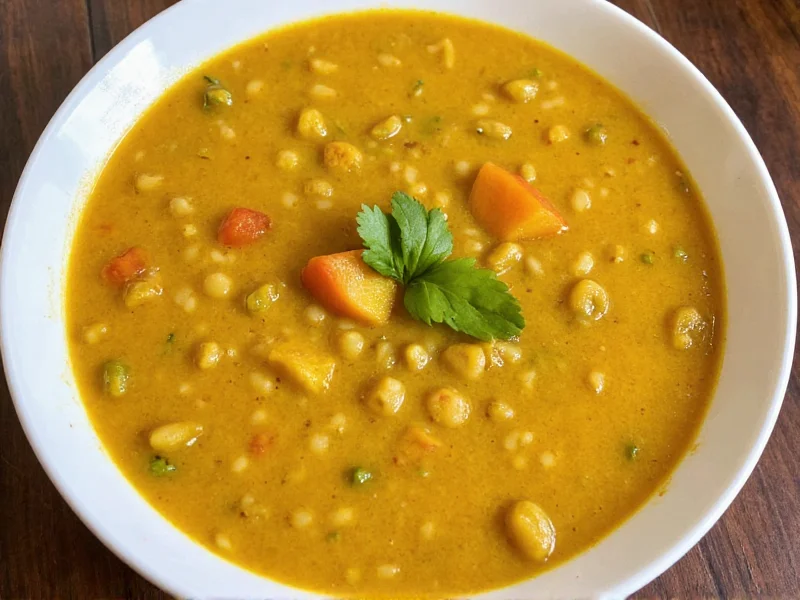Creating exceptional curry lentil soup requires understanding the culinary science behind flavor development and texture management. Unlike basic recipe searches that provide only ingredient lists, this guide reveals the professional techniques that transform simple pantry staples into a restaurant-quality dish with balanced flavors and perfect consistency.
The Science Behind Flavorful Curry Lentil Soup
Lentils contain natural starches that, when properly managed, create a velvety texture without dairy. The key lies in the Maillard reaction—browning onions and garlic before adding liquid develops complex flavor compounds that simmering alone cannot achieve. Curry spices like turmeric, cumin, and coriander release their essential oils when heated in oil first, a technique called tadka in Indian cooking, which maximizes flavor extraction.
Essential Ingredients and Their Culinary Purpose
Understanding each component's role helps you adapt the recipe confidently. This isn't just another easy curry lentil soup recipe—it's a framework for culinary success.
| Ingredient | Function | Substitution Options |
|---|---|---|
| Red lentils | Break down easily for creamy texture | Yellow lentils (similar cooking time) |
| Onion-garlic-ginger base | Flavor foundation through caramelization | Shallots for sweeter profile |
| Curry powder blend | Complex spice profile | Homemade mix: 2tsp turmeric, 1tsp cumin, 1tsp coriander |
| Coconut milk | Creaminess and fat-soluble spice carrier | Vegetable broth for lower fat version |
Professional-Grade Preparation Method
Achieving authentic curry lentil soup ingredients balance requires precise timing. Most home cooks make the critical error of adding spices too late, resulting in flat flavors.
- Bloom spices first: Heat 2 tbsp oil, add 2 tbsp curry powder and 1 tsp mustard seeds, cook 60 seconds until fragrant—this activates flavor compounds
- Caramelize the base: Add 1 chopped onion, cook 8-10 minutes until golden brown (not just translucent)
- Layer flavors: Stir in 3 minced garlic cloves and 1 tbsp grated ginger, cook 2 minutes until raw edge disappears
- Add acid early: Deglaze with 1 cup vegetable broth, scraping browned bits from pot bottom
- Simmer properly: Add 1.5 cups rinsed red lentils and 3 cups broth, simmer 20-25 minutes until lentils break down
- Finish with fat: Stir in 1 can coconut milk during last 5 minutes to preserve delicate flavors
Avoiding Common Curry Lentil Soup Mistakes
Even experienced cooks encounter these pitfalls when preparing healthy vegetarian curry lentil soup:
- Overcooking lentils: Red lentils disintegrate completely in 25 minutes—longer creates unpleasant texture
- Adding spices too late: Heat-sensitive compounds in curry spices evaporate if not bloomed properly
- Skipping acid balance: Finish with 1 tbsp lemon juice to brighten flavors that become flat during cooking
- Incorrect liquid ratio: 1:2.5 lentil-to-liquid ratio prevents both watery and overly thick results
Nutritional Benefits Backed by Research
This gluten-free curry lentil soup recipe delivers significant health advantages beyond basic nutrition:
- Complete plant protein: Lentils provide all nine essential amino acids when combined with rice
- Fiber powerhouse: 15g fiber per serving supports gut health and sustained energy
- Anti-inflammatory compounds: Turmeric's curcumin has demonstrated anti-inflammatory effects in clinical studies
- Iron absorption boost: Vitamin C from tomatoes enhances non-heme iron absorption from lentils
Variations for Dietary Needs and Preferences
Adapt this base recipe for specific requirements while maintaining authentic flavor profiles:
- Creamy version: Blend 1/3 of soup after cooking for restaurant-style texture without extra fat
- Protein boost: Add 1 cup chickpeas during last 10 minutes for additional protein complexity
- Spice adjustment: For milder traditional Indian curry lentil soup, reduce curry powder by 50% and add 1/2 cup mango chutney
- Quick preparation: Use pre-cooked lentils to create quick curry lentil soup preparation in 20 minutes
Serving and Storage Best Practices
Flavor development continues after cooking. For optimal results with your coconut milk curry lentil soup variation:
- Rest 15 minutes before serving to allow flavors to meld
- Store in airtight container for up to 5 days—flavors improve on day two
- Freeze for up to 3 months (omit coconut milk if freezing, add when reheating)
- Reheat gently over medium-low to prevent separation of coconut milk
How can I thicken curry lentil soup without altering flavor?
Blend 1 cup of cooked soup and stir it back in. This maintains flavor while creating restaurant-quality texture. Alternatively, simmer uncovered for 5-7 minutes to reduce liquid naturally without concentrating flavors excessively.
What's the best way to store leftovers for maximum freshness?
Cool completely before storing in airtight containers. The soup maintains optimal flavor for 3-4 days refrigerated. For longer storage, freeze in portion-sized containers without coconut milk, then add fresh coconut milk when reheating. This prevents separation and preserves creamy texture.
Can I make curry lentil soup without coconut milk?
Yes, substitute with full-fat yogurt (stir in off-heat to prevent curdling) or cashew cream for similar richness. For lower fat content, use 1/2 cup blended cooked potatoes with additional vegetable broth. The soup remains authentically flavorful while accommodating dietary restrictions.
Why do my lentils remain hard even after cooking?
Old lentils lose moisture and take longer to cook. Always check package dates and store in airtight containers. If using older lentils, soak 1 hour before cooking or add 1/4 tsp baking soda to cooking water to soften them. Avoid adding acidic ingredients like tomatoes until lentils are nearly tender, as acid prevents softening.











 浙公网安备
33010002000092号
浙公网安备
33010002000092号 浙B2-20120091-4
浙B2-20120091-4